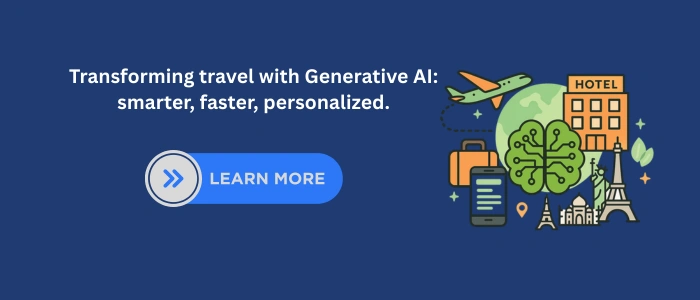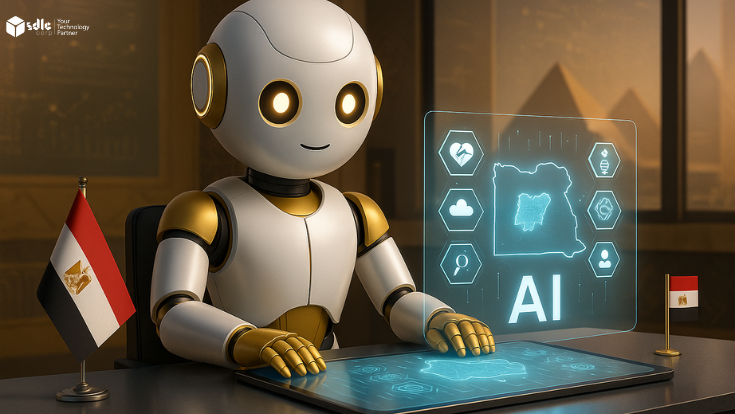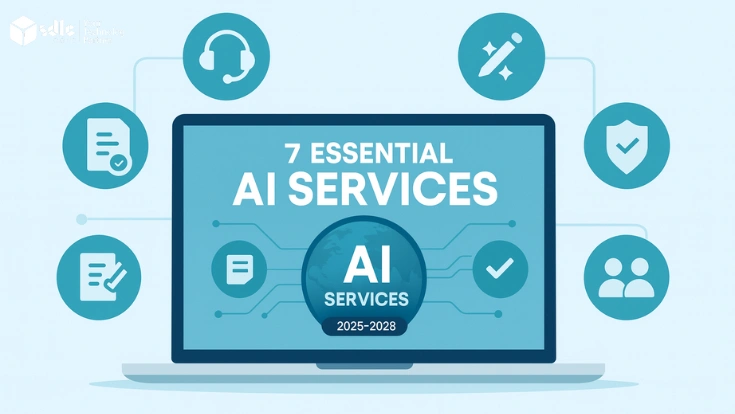Introduction
Generative AI in tourism is transforming the way travel experiences are designed, delivered, and personalized. Travelers today expect more than standard packages; they want journeys tailored to their preferences, budgets, and timing. At the same time, tourism businesses face pressure to manage fluctuating demand, adjust pricing strategies, and streamline booking processes.
As a result, traditional methods of travel planning and management are no longer enough. Generative AI addresses these challenges by combining automation with intelligence. It enables businesses to create personalized itineraries, deliver AI-powered travel recommendations, forecast demand more accurately, and introduce dynamic pricing models that remain competitive.
Generative AI addresses both sides, making the travel experience smoother for customers and more efficient for providers. Moreover, it combines automation with intelligence, ensuring that businesses can adapt to changing expectations.
This blog explores how generative AI is driving change in tourism from automated content and itinerary planning to demand forecasting, pricing, and booking personalization. For related insights, you can also read our article on AI for Retail
The Role of Generative AI in Tourism
Generative AI is increasingly used to create dynamic itineraries, destination insights, and travel recommendations based on traveler preferences and constraints. These systems generate contextual outputs that adapt in real time. Organizations developing such capabilities often rely on Generative AI development services to build models aligned with travel data and user behavior.
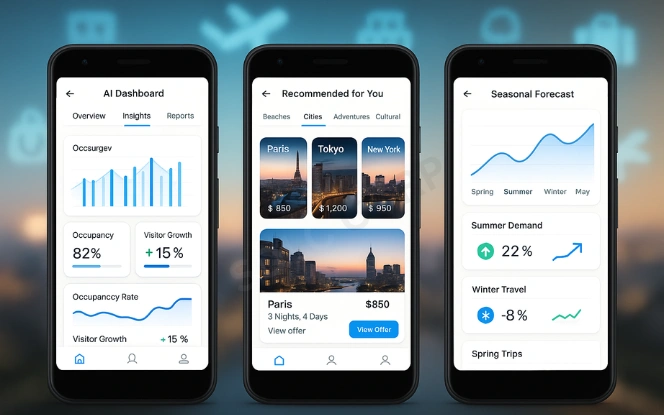
Generative AI is a subset of artificial intelligence that creates new content, predictions, or insights from existing data. For tourism, this means producing tailored travel plans, real-time recommendations, and predictive business insights.
Practical applications include:
- Creating personalized travel itineraries based on user profiles.
- Offering content such as destination guides or cultural insights.
- Forecasting seasonal demand and optimizing resource allocation.
- Adjusting pricing models to match customer behavior and market shifts.
When used well, generative AI improves customer trust by providing relevant and transparent solutions. In addition, it delivers both scale and intelligence, allowing tourism businesses to move beyond reactive strategies.
Automating Travel Itineraries with AI
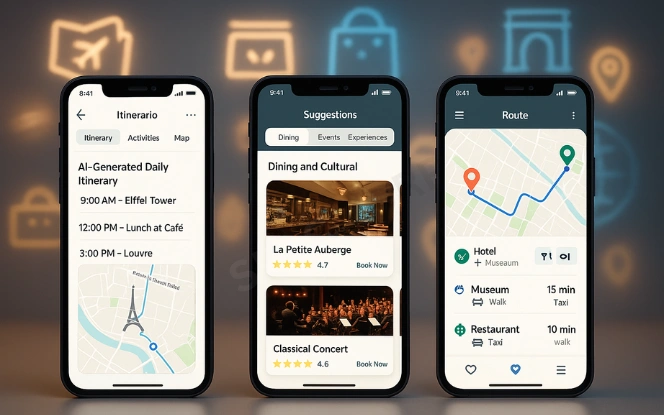
One of the biggest challenges for travelers is building an itinerary that balances time, cost, and experience. With automating travel itineraries with AI, this process becomes seamless.
How it works:
- AI collects user preferences like budget, travel style, and time available.
- It analyzes local conditions such as weather, traffic, and opening hours.
- It generates an itinerary with recommendations for attractions, dining, and accommodation.
Benefits for travelers:
- Less time spent researching.
- More confidence in chosen destinations.
- Better balance between sightseeing and relaxation.
Benefits for providers:
- Faster onboarding of customers with pre-built itineraries.
- Improved upselling opportunities through tailored experiences.
- Stronger engagement with repeat travelers.
This mix of automation and personalization makes itineraries more reliable and convenient for travelers. Furthermore, it frees tourism companies from repetitive tasks, allowing them to focus on customer service. For more practical applications, see our guide on Generative AI for Hospitality
AI-Powered Travel Recommendations

Generic recommendations are no longer enough. Modern travelers expect advice that reflects their individual needs. With AI-powered travel recommendations, businesses can meet this demand more effectively.
How it works:
- AI systems analyze booking history, search patterns, and feedback.
- They generate recommendations that fit the traveler’s intent.
- Suggestions adapt in real time as users explore new options.
Example:
A traveler booking a beach resort may also receive recommendations for local water sports, nearby cultural tours, or wellness retreats. In addition, the system may highlight seasonal activities that align with the traveler’s profile.
Business benefits:
- Higher customer satisfaction.
- Increased cross-sell and upsell opportunities.
- Better alignment with customer expectations.
Because recommendations feel personal rather than generic, travelers are more likely to trust them. As a result, loyalty strengthens, and businesses see more repeat customers.
Demand Forecasting for Tourism Using AI
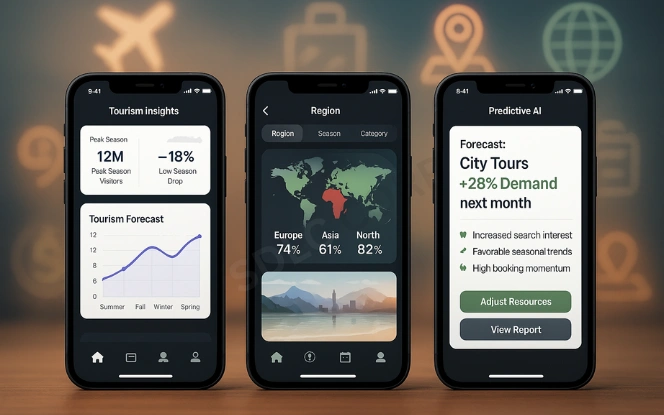
Tourism is highly seasonal, and demand often changes quickly. Demand forecasting for tourism using AI gives businesses the ability to anticipate changes rather than react to them.
How it works:
- AI analyzes past booking data, economic trends, and local events.
- It predicts demand surges for destinations or services.
- Businesses can adjust resources such as staff, transportation, and inventory.
Example:
An airline can use AI to anticipate holiday season demand and allocate flights accordingly. Similarly, a hotel can forecast occupancy trends and prepare staff levels in advance.
Impact:
- Reduced overbooking risks.
- Lower costs from resource mismanagement.
- Improved customer experiences with better service levels.
By anticipating demand shifts, businesses can align operations with customer needs and market conditions. Consequently, decision-making becomes proactive rather than reactive. For connected approaches, explore our write-up on predictive analytics in tourism management.
Dynamic Pricing in Travel with AI
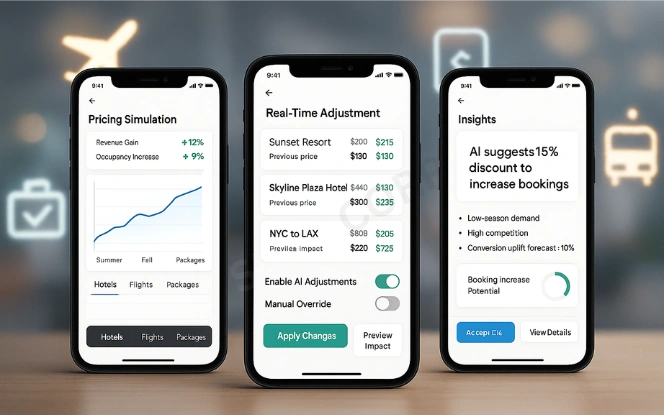
Pricing is critical in tourism, yet static models fail to adapt to real-time changes. With dynamic pricing in travel with AI, businesses can optimize revenue while maintaining fairness.
How it works:
- AI monitors booking patterns, competitor rates, and demand levels.
- It adjusts prices automatically for different customer segments.
- It ensures competitive offers without undercutting profitability.
Example:
A hotel may reduce prices slightly during low demand periods to attract bookings. Conversely, it may increase rates when a major local event creates high demand.
Advantages:
- Fair and flexible pricing strategies.
- Higher occupancy and revenue.
- Improved customer trust when pricing changes are transparent.
Moreover, dynamic pricing ensures that both customers and providers benefit from balanced market conditions. Therefore, it is one of the most impactful applications of AI in tourism.
AI-Driven Booking Personalization
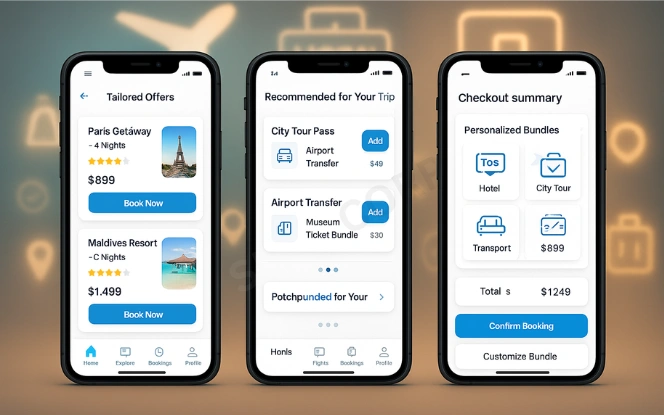
Booking is often the traveler’s first direct interaction with a tourism business. With AI-driven booking personalization, that experience becomes far more engaging.
How it works:
- AI uses browsing and booking history to predict needs.
- It adapts booking interfaces with tailored offers.
- It streamlines the checkout process with relevant add-ons.
Example:
A customer booking a city tour may be offered discounted transport or bundled museum passes. In addition, someone booking a mountain trek may see camping gear recommendations.
Impact:
- Faster bookings with less effort.
- Increased basket sizes from relevant upselling.
- Stronger loyalty due to personalized service.
Personalization at the booking stage creates a stronger bond with the customer. Therefore, businesses that apply it responsibly see significant gains in both satisfaction and revenue. To learn how this links with broader engagement, check out our piece on Generative AI for Foodtech
Benefits of Generative AI for Tourism Businesses
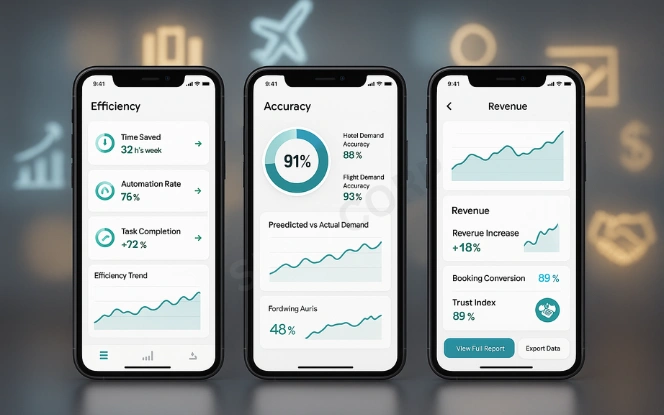
The advantages extend beyond the customer experience. Tourism providers benefit operationally as well.
Key benefits:
- Efficiency: Automation reduces manual effort.
- Accuracy: Forecasting improves resource allocation.
- Revenue: Dynamic pricing optimizes margins.
- Trust: Personalization builds stronger relationships.
Together, these factors create a cycle of improved profitability and customer satisfaction. Furthermore, they position tourism businesses to adapt quickly in competitive markets.
Challenges and Considerations
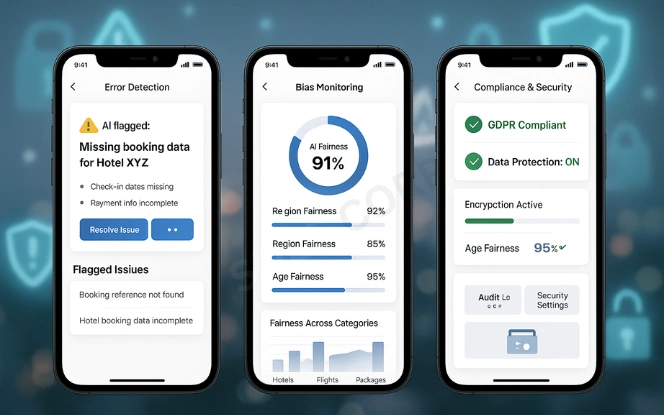
Despite its promise, generative AI in tourism is not without risks.
Key challenges include:
- Data quality: Poor data leads to poor predictions.
- Bias: AI can replicate unfair patterns if not monitored.
- Transparency: Customers need to understand how recommendations are generated.
- Costs: Building and maintaining AI systems requires investment.
Best practice involves combining AI systems with human oversight. In addition, open communication with customers builds trust and helps maintain transparency. This ensures recommendations are accurate, ethical, and aligned with expectations.
Best Practices for Adoption
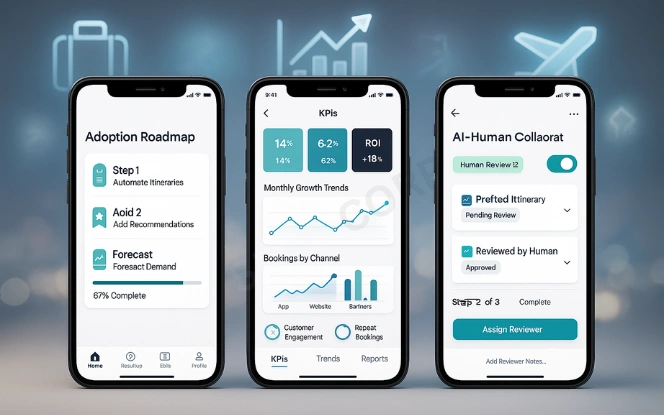
Tourism businesses considering generative AI should take a phased approach.
Steps for success:
- Start small with a pilot project like itinerary automation.
- Measure results with KPIs such as booking completion rates or revenue per traveler.
- Expand gradually into forecasting, pricing, and personalization.
- Ensure compliance with privacy and data protection laws.
- Blend automation with human expertise to maintain authenticity.
By following these steps, businesses reduce risks while maximizing value. Furthermore, they create a sustainable path for long-term success.
Generative AI Expertise and Development Teams
Maintaining generative AI systems for tourism requires expertise in user behavior modeling, data integration, and system monitoring. Some organizations choose to hire generative AI developers to manage model lifecycle processes and adapt systems to changing travel patterns.
Conclusion
Generative AI is not just another technology trend. It is becoming a core tool that reshapes how tourism businesses interact with customers and manage operations. From automating travel itineraries with AI to AI-powered travel recommendations, and from demand forecasting for tourism using AI to dynamic pricing in travel with AI, the opportunities are clear. Moreover, AI-driven booking personalization ensures that every customer receives a unique and relevant journey.
For travelers, this means more convenience, fairness, and engagement. For providers, it delivers efficiency, accuracy, and profitability.
Contact us SDLC Corp to explore how your tourism business can implement these solutions. If you are ready to act, Hire AI Development Services with SDLC Corp and bring generative AI into your travel operations.
FAQs
How Is Generative AI In Tourism Changing The Travel Industry?
Generative AI in tourism is transforming the industry by creating personalized travel plans, predicting demand, and automating services. It allows businesses to reduce manual work while offering tailored experiences for travelers.
What Are The Benefits Of AI-Powered Travel Recommendations?
AI-powered travel recommendations analyze customer preferences, booking history, and behavior to provide tailored suggestions. This improves customer satisfaction, increases bookings, and encourages upselling.
How Does Automating Travel Itineraries With AI Help Travelers?
Automating travel itineraries with AI helps travelers save time, reduce stress, and enjoy well-balanced plans. It ensures that activities, accommodation, and travel logistics are aligned with personal preferences and budget.
What Is The Role Of Dynamic Pricing In Travel With AI?
Dynamic pricing in travel with AI adjusts rates in real time based on demand, season, and competitor pricing. This helps travel companies optimize revenue while keeping prices competitive and fair for customers.
How Does AI-Driven Booking Personalization Improve Customer Experience?
AI-driven booking personalization tailors the booking journey with relevant offers, add-ons, and faster checkout. As a result, customers see more relevant options, which increases loyalty and improves overall satisfaction.

